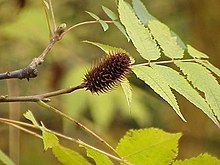bio.wikisort.org - Plant
Platycarya is a genus of flowering plants in the family Juglandaceae native to eastern Asia in China, Korea, and Japan.[1][2]

| Platycarya Temporal range: | |
|---|---|
 | |
| Autumn foliage and fruit | |
| Scientific classification | |
| Kingdom: | Plantae |
| Clade: | Tracheophytes |
| Clade: | Angiosperms |
| Clade: | Eudicots |
| Clade: | Rosids |
| Order: | Fagales |
| Family: | Juglandaceae |
| Subfamily: | Juglandoideae |
| Tribe: | Platycaryeae |
| Genus: | Platycarya Siebold & Zucc. |
| Species | |
| |
| Synonyms | |
| |
It is a deciduous tree growing to 15 m tall. The leaves are usually pinnate, 15–30 cm long with 7–15 leaflets (rarely simple, or with up to 23 leaflets), the terminal leaflet present; the leaflets are 3–11 cm long and 1.5–3.5 cm broad. The flowers are presented as catkins; the male (pollen) catkins are 2–15 cm long, the female catkins 2.5–5 cm long at maturity, hard and woody, superficially resembling a conifer cone with spirally arranged scales.[1][2]
The genus was formerly treated as comprising a single species Platycarya strobilacea, though the second living species Platycarya longzhouensis is now recognized.[3] A number of fossil species have been discovered across the Northern Hemisphere dating from the Early Eocene,[4] although they became confined to eastern Asia during the Pleistocene ice ages.[5][6]
- †Platycarya americana Hickey[7]
- †Platycarya bognorensis (Chandler) Wing & Hickey
- †Platycarya castaneopsis (Lesquereux) Wing & Hickey
- †Platycarya manchesterii Wing & Hickey
- †Platycarya miocenica Hu & Chaney
- †Platycarya pseudobrauni (Hollick) Wolfe
- †Platycarya richardsoni (sic P. richardsonii) (Bowerbank) Chandler[7][8]
References
- Flora of China: Platycarya
- Flora of China: Platycarya strobilacea
- Wan, Q.; Zheng, Z.; Huang, K.; Guichoux, E.; Petit, R. J. (2017). "Genetic divergence within the monotypic tree genus Platycarya (Juglandaceae) and its implications for species' past dynamics in subtropical China". Tree Genetics & Genomes. 13 (4): 1–11. doi:10.1007/s11295-017-1153-9. S2CID 25199346.
- Wing, S. L.; Hickey, L. J. (1984). "The Platycarya perplex and the evolution of the Juglandaceae". American Journal of Botany. 71 (3): 388–411. doi:10.1002/j.1537-2197.1984.tb12525.x.
- Wing, Scott L.; Hickey, Leo J. (1984). "The Platycarya Perplex and the Evolution of the Juglandaceae". American Journal of Botany. 71 (3): 388–411. doi:10.2307/2443497. JSTOR 2443497.
- Sutton, Julian (2019). "'Platycarya' from the website Trees and Shrubs Online". Retrieved 2022-01-25.
- "Fossilworks: Platycarya".
- Manchester, S. (1987). "Fossil History of the Juglandaceae". Annals of the Missouri Botanical Garden. 21: 1–137.
 Media related to Platycarya at Wikimedia Commons
Media related to Platycarya at Wikimedia Commons
На других языках
- [en] Platycarya
[es] Platycarya
El género botánico Platycarya pertenece a la familia de las juglandáceas.Другой контент может иметь иную лицензию. Перед использованием материалов сайта WikiSort.org внимательно изучите правила лицензирования конкретных элементов наполнения сайта.
WikiSort.org - проект по пересортировке и дополнению контента Википедии